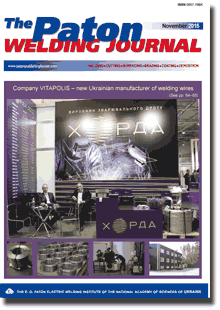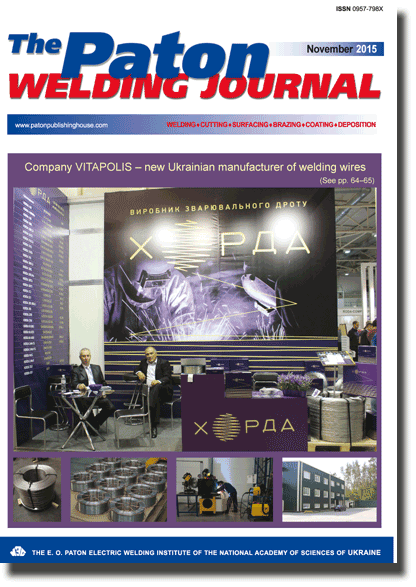| 2015 №11 (09) |
DOI of Article 10.15407/tpwj2015.11.01 |
2015 №11 (02) |

The Paton Welding Journal, 2015, #11, 10-16 pages
Structure and properties of weld metal modified by nanooxides
V.D. Kuznetsov And D.V. Stepanov
NTTU «Kiev Polytechnic Institute» 37 Pobeda Ave., 03056, Kiev, Ukraine. E-mail: v.kuznetsov@kpi.ua
Abstract
Given are the results of investigation of structure and properties of weld metals at introduction of nanooxide powders into weld pool. It is shown that portion of nanooxides, being introduced in the weld pool, should not exceed 0.5 % in a range of recommended modes of welding of low-alloy steels. It is determined that nanooxides introduction results in formation of mainly non-metallic inclusions in nanosize range of 0.07-0.13mm as well as in 0.3-0.8 mm range. At that increased content of carbon, titanium, oxygen, aluminum and manganese are observed in them in comparison to reference welds. It is shown that introduction of 0.5% titanium nanooxide reduces content of brittle constituents of the structure and content of acicular ferrite rises to 40 %, that results in 2 times increase of impact toughness together with simultaneous increase of yield strength. It is shown that modifying of weld metal by titanium and aluminum nanooxides reduces solidification interval, that can indicate their effect as 2nd type inoculants. 15 Ref., 3 Tables, 6 Figures.
Keywords: weld, low-alloy steel, nanopowder, nanooxides, structure, non-metallic inclusions, mechanical properties, solidification interval
Received: 21.10.15
Published: 21.12.15
References
- Takamura, J., Mizoguchi, S. (1990) Roles of oxides in steels performance - Metallurgy of oxides in steels. In: Proc. of 6th Int. Iron and Steel Conf. (Tokyo, Japan, 1990), Vol. 1, 591-597.
- Grong, O., Kolbeinsen, L., van der Eijk, C. et al. (2006) Microstructure control of steels through dispersoid metallurgy using novel grain refining alloys. ISIJ Int., 46, 824-831. https://doi.org/10.2355/isijinternational.46.824
- Lee, T.K., Kim, H.J., Kang, B.Y. et al. (2000) Effect of inclusion size on the nucleation of acicular ferrite in welds. Ibid., 40, 1260-1268. https://doi.org/10.2355/isijinternational.40.1260
- Yamamoto, K., Hasegawa, T., Takamura, J. (1996) Effect of boron on intra-granular ferrite formation in Ti-oxide bearing steel. Ibid., 36, 80-86. https://doi.org/10.2355/isijinternational.36.80
- Vanovsek, W., Bernhard, C., Fiedler, M. et al. (2013) Influence of aluminium content on the characterization of microstructure and inclusions in high-strength steel welds. Welding in the World, Issue 1, 57, 73-83. https://doi.org/10.1007/s40194-012-0008-0
- Seo, J.S., Kim, H.L., Lee, C. (2013) Effect of Ti addition on weld microstructure and inclusion characteristics of bainitic GMA welds. ISIJ Int., 53(5), 880-886. https://doi.org/10.2355/isijinternational.53.880
- Golovko, V.V., Grigorenko, G.M., Kostin, V.A. (2011) Influence of nanoinclusions on formation of weld metal structure of ferritic-bainitic steels (Review). Zbirnyk Nauk. Prats NUK, 4, 42-49.
- Pokhodnya, I.K., Golovko, V.V., Stepanyuk, S.M. et al. (2012) Study of effect of titanium nanocarbides on formation of microstructure and properties of weld. FKhMM, 6, 68-75.
- Golovko, V.V., Stepanyuk, S.M., Ermolenko, D.Yu. (2012) Study of influence of nanoformation in metal on microstructure formation of weld and its mechanical properties. In: Transact. on Building, materials science, machine-building, Issue 64, 155-159.
- Golovko, V.V., Pokhodnya, I.K. (2013) Effect of non-metallic inclusions on formation of structure of the weld metal in high-strength low-alloy steels. The Paton Welding J., 6, 2-10.
- Golovko, V.V., Stepanyuk, S.N., Ermolenko, D.Yu. (2014) Technology of welding of high-strength low-alloy steels with introduction of titanium-containing inoculants. In: Nanosized systems and materials in Ukraine, 395-399. Kiev: Akademperiodika.
- Golovko, V.V., Stepanyuk, S.M., Ermolenko, D.Yu. (2015) Effect of titanium-containing inoculants on structure and properties of weld metal of high-strength low-alloy steels. The Paton Welding J., 2, 14-18. https://doi.org/10.15407/tpwj2015.02.03
- Grigorenko, G.M., Kostin, V.A., Golovko, V.V. et al. (2015) Effect of nanopowder inoculants on structure and properties of cast metal of high-strength low-alloy steels. Sovr. Elektrometallurgiya, 2, 32-41.
- Kuznetsov, V.D., Loboda, P.I., Fomichov, S.K. et al. Method of electric arc welding with introduction of nanocomponents into weld pool. Pat. 98985 UA. Int. Cl. B 23K 9/16. Fill. 15.12.14. Publ. 12.05.15.
- Ragulya, A.V., Skorokhod, V.V. (2007) Consolidated nanostructural materials. Kyiv: Naukova Dumka.
Suggested Citation
V.D. Kuznetsov And D.V. Stepanov (2015) Structure and properties of weld metal modified by nanooxides. The Paton Welding J., 11, 10-16.The cost of subscription/purchase order journals or individual articles
| Journal/Currency | Annual Set | 1 issue printed |
1 issue |
one article |
| TPWJ/USD | 384 $ | 32 $ | 26 $ | 13 $ |
| TPWJ/EUR | 348 € | 29 € | 24 € | 12 € |
| TPWJ/UAH | 7200 UAH | 600 UAH | 600 UAH | 280 UAH |
| AS/UAH | 1800 UAH | 300 UAH | 300 UAH | 150 UAH |
| AS/USD | 192 $ | 32 $ | 26 $ | 13 $ |
| AS/EUR | 180 € | 30 € | 25 € | 12 € |
| SEM/UAH | 1200 UAH | 300 UAH | 300 UAH | 150 UAH |
| SEM/USD | 128 $ | 32 $ | 26 $ | 13 $ |
| SEM/EUR | 120 € | 30 € | 25 € | 12 € |
| TDNK/UAH | 1200 UAH | 300 UAH | 300 UAH | 150 UAH |
| TDNK/USD | 128 $ | 32 $ | 26 $ | 13 $ |
| TDNK/EUR | 120 € | 30 € | 25 € | 15 € |
AS = «Automatic Welding» - 6 issues per year;
TPWJ = «PATON WELDING JOURNAL» - 12 issues per year;
SEM = «Electrometallurgy Today» - 4 issues per year;
TDNK = «Technical Diagnostics and Non-Destructive Testing» - 4 issues per year.


